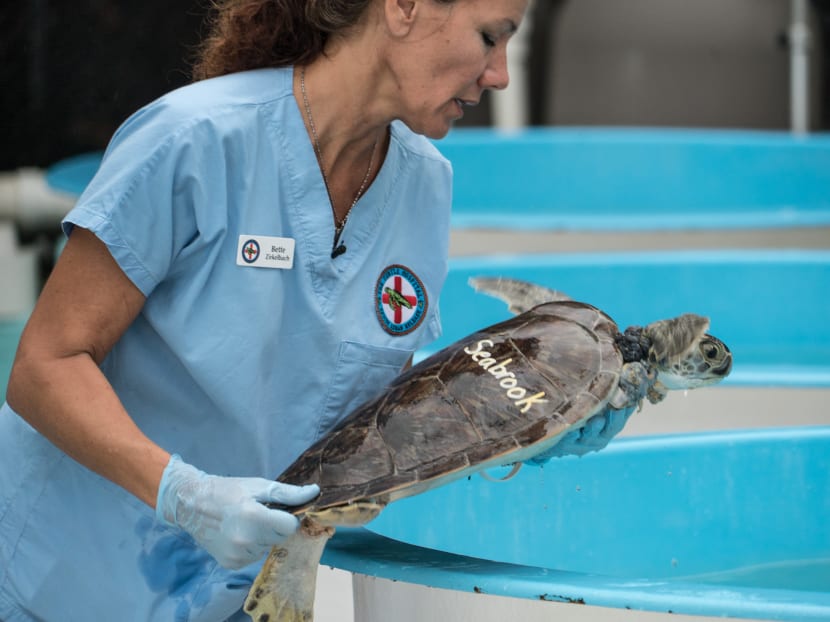Green sea turtles of Florida, Mexico no longer ‘endangered’
MIAMI — Green sea turtles of Florida and the Pacific coast of Mexico are no longer considered “endangered”, US officials said Tuesday (April 5), hailing decades of conservation work for saving the long-imperiled creatures.

This photo shows a green sea turtle afflicted by a kind of herpes virus that causes fibropapillomatosis at the Turtle Hospital in Marathon, Florida in the Florida Keys. AFP file photo
MIAMI — Green sea turtles of Florida and the Pacific coast of Mexico are no longer considered “endangered”, US officials said Tuesday (April 5), hailing decades of conservation work for saving the long-imperiled creatures.
Breeding populations on the beaches of Florida and the west coast of Mexico are now described as “threatened” and still merit protection under the Endangered Species Act, but do not face an imminent risk of extinction, the US Fish and Wildlife Service said.
In Florida alone, there are some 2,250 nesting females counted on beaches each year, up from only a handful in 1978 when the breeding populations were first listed as endangered, an FWS spokesman said.
As part of the change, the US FWS and the National Oceanic and Atmospheric Administration (NOAA) Fisheries divided green sea turtles (Chelonia mydas) globally into 11 distinct population segments, “allowing for tailored conservation approaches for each population”, the agencies said in a statement.
That leaves three populations of green sea turtles worldwide that are considered endangered and at the highest risk of disappearing from the planet — those that live in the Mediterranean Sea as well as the Central South Pacific and Central West Pacific Ocean.
Most of the world’s populations of green sea turtles are listed as “threatened”.
The changes were initially proposed last year and made final on Tuesday after officials reviewed the scientific data and an outpouring of more than 900 public comments.
“Successful conservation and management efforts developed in Florida and along the Pacific coast of Mexico are a roadmap for further recovery strategies of green turtle populations around the world,” said Ms Eileen Sobeck, assistant NOAA administrator for fisheries.
Sea turtles have long faced a host of threats, from beach development that destroyed their nesting habitat, to pollution, to fishing nets that entangled them.
Successful measures have included protection of nesting beaches, reduction of bycatch in fisheries and prohibitions on the direct harvest of sea turtles, NOAA said.
BY THE NUMBERS
Officials at NOAA estimate that there are currently 571,220 nesting female green sea turtles around the world.
The largest population, including more than 167,000 females, lives in the North Atlantic.
By contrast, among the endangered populations, between 404 and 992 are believed to live in the Mediterranean, and just over 9,000 in the Central West and Central South Pacific, a spokeswoman for NOAA said.
Challenges remain, including climate change and sea level rise that may erode beach nesting habitat and raise the temperature of sand, which can “result in skewed sex ratios and lethal incubation conditions,” the agencies noted in a 134-page document in the federal register.
Some commenters raised concern about a herpes-related virus called fibropapillomatosis, or FP, which is common among young green sea turtles in warmer waters, and can cause fatal tumours.
“We acknowledge the increasing distribution and incidence of FP, particularly in Florida. The threat is likely to increase” along with human-driven pollution of the shores, the agencies said.
Dangerous fishing gear and boat strikes also kill significant numbers of turtles each year.
“Sea turtles face a lot of threats, from plastic trash they swallow to sea-level rise to getting caught in fishing gear — even poaching, in some parts of the world,” said Ms Catherine Kilduff of the Center for Biological Diversity.
“The undeniable recovery of most green sea turtle populations creates a hopeful spot in our changing oceans.” AFP





